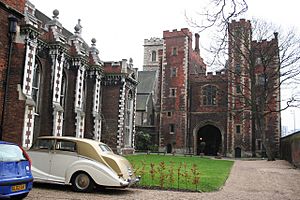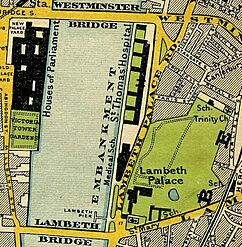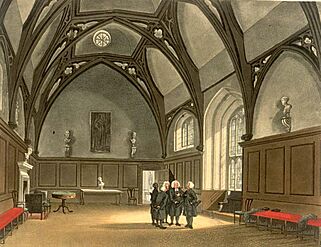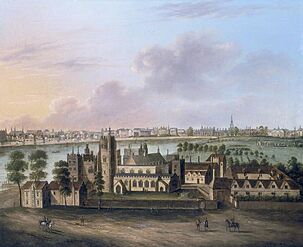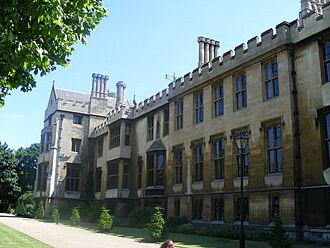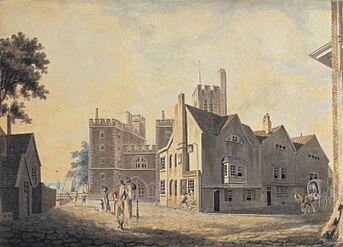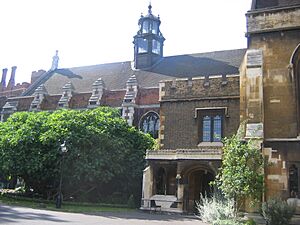Lambeth Palace facts for kids
Quick facts for kids Lambeth Palace |
|
|---|---|
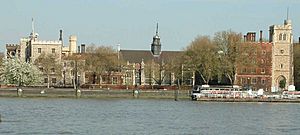
Lambeth Palace, photographed looking east across the River Thames. Visible are the 15th-century Lollards' Tower at left, the 17th-century Great Hall (with cupola) at centre, the late 15th-century brick gatehouse towards the right, and the 14th-century tower of St Mary-at-Lambeth on the far right.
|
|
| Type | Archbishop's palace |
| Location | Lambeth, London |
| Architectural style(s) | Tudor |
| Owner | See of Canterbury |
|
Listed Building – Grade I
|
|
| Official name: Lambeth Palace | |
| Designated | 19 October 1951 |
| Reference no. | 1116399 |
| Official name: Lambeth Palace | |
| Designated | 1 October 1987 |
| Reference no. | 1000818 |
| Lua error in Module:Location_map at line 420: attempt to index field 'wikibase' (a nil value). | |
Lambeth Palace is a very old and important building in London. It is the official home of the Archbishop of Canterbury, who is the main leader of the Church of England. The palace is located on the south bank of the River Thames, not far from the Palace of Westminster, where the UK Parliament meets.
The land for the palace was bought by the Archbishop's church around the year 1200. It was a good spot because it was close to the royal palace and the government in Westminster.
Contents
History of Lambeth Palace
The Archbishop of Canterbury's main home was originally in Canterbury. But around 1200, a place called the Manor of Lambeth was bought. This became the Archbishop's London home. It was chosen because it was easy to get to Westminster, just across the River Thames.
The area around the palace used to be marshy and developed slowly. The name Lambeth comes from "Lambehitha," which means 'landing place for lambs'. Archbishops often traveled by boat.
Attacks and Rebuilding
Lambeth Palace has seen many historical events. In 1378, a religious leader named John Wycliffe was put on trial here. In 1381, during the Peasants' Revolt, the palace was attacked.
Later, in 1640, the palace was attacked again. This happened during a time when people were unhappy with the Archbishop, William Laud. During the English Civil War in the 1640s, the palace was badly damaged. It was even partly pulled down by the Parliamentarians.
After the war, the palace needed a lot of repair. The Great Hall, a large meeting room, was rebuilt between 1660 and 1663. In the early 1800s, a famous architect named Edward Blore added new parts to the palace. He rebuilt parts of Buckingham Palace too. His additions gave the palace a new look and made space for the Archbishop's library and offices.
During The Blitz in 1941, the palace was damaged again. Today, it remains the home of the Archbishop, who is a very important figure in the Anglican Communion.
Buildings of Lambeth Palace
Lambeth Palace is a very important historical building. It is made up of two main parts: the Archbishop's home, which is built around a courtyard, and Morton's Tower, which is the main entrance. In the past, the palace had more courtyards and even a moat around it.
Oldest Parts and Towers
The oldest part of the palace that is still standing is the chapel. It was built in the 1200s in a style called English Gothic architecture. This chapel had to be repaired a lot after the damage from the Blitz in 1941.
One room from the 1300s, called the Guard Chamber, still has its original fancy roof. Another important part is the Water Tower, also known as the Lollards' Tower. It was built in 1434-35 and was used as a prison for the Archbishop.
The large brick gatehouse was finished in 1495 by Cardinal John Morton. It has five floors and used to house eight people from the Archbishop's staff. In the 1500s, Archbishop Thomas Cranmer added a brick tower near the chapel for his study.
The Great Hall
The Great Hall was destroyed during the English Civil War. It was completely rebuilt in 1663 by Archbishop William Juxon. The new hall has a special type of roof called a hammerbeam roof. This style was chosen to show that the old traditions of the church were returning after the war.
Many famous artists have painted portraits of the Archbishops that hang in the palace. These include works by Hans Holbein the Younger, Anthony van Dyck, William Hogarth, and Sir Joshua Reynolds.
-
Map of the Thames between Westminster and Lambeth Bridges, with Westminster Palace on the west bank and Lambeth Palace on the east, 1897
-
Lambeth Palace by J. M. W. Turner, 1790
Gardens of Lambeth Palace
The gardens at Lambeth Palace are also very old and interesting. There is a fig tree in the palace courtyard that is thought to have grown from a cutting taken from a tree planted centuries ago. Some say it was planted by Cardinal Pole.
In the past, the palace had a large orchard. Today, parts of the original garden have become a public park and roads with houses and offices. The palace gardens were officially listed as important historical gardens in 1987.
Lambeth Palace Library
Inside the palace grounds is the Lambeth Palace Library. This is the official library of the Archbishop of Canterbury. It holds many important records of the Church of England. It is known as one of the largest religious collections outside of the Vatican Library.
The library was started in 1610 by Archbishop Richard Bancroft. For a long time, it was located inside the main palace. But in 2021, a brand new building for the library and its collections opened. This new building is at the far end of the palace gardens.
The library has a huge collection of materials about church history. It includes records from the Archbishops going back to the 1100s. It also has archives from other church groups and missionary societies. Some of its oldest manuscripts date back to the 800s. The library also holds over 120,000 printed books.
The collections cover many topics, from art and architecture to the history of the Commonwealth of Nations. It's also a great place to find information for local history and genealogy (family history).
Special Items in the Collection
Some of the most famous items in the library's collection include:
- Mac Durnan Gospels (from the late 800s or early 900s)
- The Romanesque Lambeth Bible (from the 1100s)
- Book of Hours of King Richard III (from the mid-1400s)
- A very rare copy of the Gutenberg Bible (from the 1450s)
St Mary-at-Lambeth Church
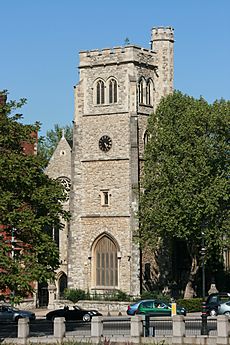
Right outside the palace gatehouse is the old church of St Mary-at-Lambeth. The tower of this church dates back to 1377. The main part of the church was rebuilt in 1851.
Many important people are buried here. These include famous gardeners John Tradescant the elder and his son, and Admiral William Bligh. The church stopped being used for services in 1972. In 1977, it became the Garden Museum, which celebrates the history of gardening.
During some repair work in 2016, a hidden crypt was found. It contained 30 coffins, including those of five former Archbishops of Canterbury.
Resident Community
Lambeth Palace is also home to the Community of Saint Anselm. This is a group of young Christians from around the world who live and pray together for a year. They are supported by the Archbishop of Canterbury.
See also
 In Spanish: Palacio de Lambeth para niños
In Spanish: Palacio de Lambeth para niños
- List of palaces
- Old Palace, Canterbury, the Archbishop's home in Canterbury
- Palace of Whitehall


